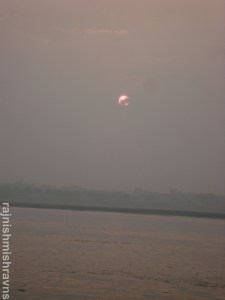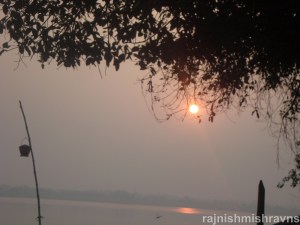The sun shines over all the cities sans discrimination. There are rivers across which it can be seen rising picturesquely. “What’s so special in Subahe Banaras (the morning in Banaras)”, said Mr. Sudhanshu Pandey from Pratapgarh, “the morning is the same in every city, take for example Allahabad”? The person asking the question was only questioning an assumption. That, in no way, called for his being called kashidrohi (Kasiphobe) and then bringing to my mind Goswami Tulsidasji’s :
जाके प्रिय न राम वैदेही।
सो छॉँड़िये कोटि बैरी सम, जद्यपि परम सनेही।।
तज्यो पिता प्रहलाद, बिभीषण बन्धु, भरत महतारी।
बलि गुरु तज्यो, कंत व्रजबनितनि, भये मुद-मंगलकारी।।
नाते नेह राम के मनियत सुह्रद सुसेव्य जहां लौं।
अंजन कहा आखि जेहि फूटै, बहुतक कहौं कहां लौं।।
तुलसी सो सब भांति परमहित पूज्य प्रान ते प्यारो।
जासों होय सनेह रामपद, एतो मतो हमारो।।
(Source: ashutoshg.blogspot.in)
Why bring in a hammer to shell peanuts? The instinct of overreaction! Yet, the analogy is not very far fetched. The lines in Hindi from Tulsidasji’s Vinay Patrika, completed in Varanasi (ironically, shall I say?), have his Lord Ram as the theme. Substitute Ram-Vaidehi with Kashi for the type that asks the kind of questions that make the title of this post and the point becomes clear.
A valid question question oughtn’t elicit a fallacious answer. Ergo, A detailed and logical answer is warranted here. The question that started it all was: “What’s so special in Subahe Banaras“? Or, the cultural-ideal hegemony of the splendid Banarsi morning was being contested through that question. The gentleman asking that harmless question in the manner of Devil’s advocate actually wanted to find out what makes my city so special and unique or uniquely special, particularly its morning.
Pierre Loti, A French traveller and writer, who had come to Banaras in the beginning of the twentieth century, describes the riverside sunrise of Benares thus:
The sun has just risen from the plain through which old Ganges wanders, a plain of mud and vegetation still overshadowed by the mists of night; and waiting there for the first red rays of dawn lie the granite temples of Benares, the rosy pyramids, the golden shafts, and all the sacred city, extended in terraces, as if to catch the first light and deck itself in the glory of the morning. This is the hour which, since the Brahmin faith began, has been sacred to prayer and to religious ecstasy, and it is now that Benares pours forth all its people, all its flowers, all its garlands, all its birds, and all its living things on to the banks of the Ganges. Awakened by the kiss of the sun, all that have received souls from Brahma rush joyously down the granite steps. (257)
Source: Loti, Pierre. India. London: T. Werner Laurie, 1913.
Mirza Ghalib was besotted by the beauty of Banaras and his Persian ode to the city, Chiragh e-Dair, The Light of the World, makes it clear. He describes the morning and evening in his inimitable manner:
May Heaven keep the grandeur of Benaras…
Morning and Moonrise,
My lady Kashi,
Picks up the Ganga mirror
To see her gracious beauty,
Glimmer and shine.
(Translated by Pavan Verma, from Ghalib: The Man and the Times published by Penguin India)
[Ghalib wrote] “I wish I had taken a rosary in my hand, put a sectarian mark on my forehead, tied a sacred thread around my waist and seated myself on the banks of the Ganges so that I could wash the contamination of existence away from myself and like a drop, be one with the river.”
(Source: groups.yahoo.com/neo/groups/Writers_Forum/conversations/topics/594)
 This work is licensed under a Creative Commons Attribution-NonCommercial-NoDerivs 3.0 Unported License.
This work is licensed under a Creative Commons Attribution-NonCommercial-NoDerivs 3.0 Unported License.

